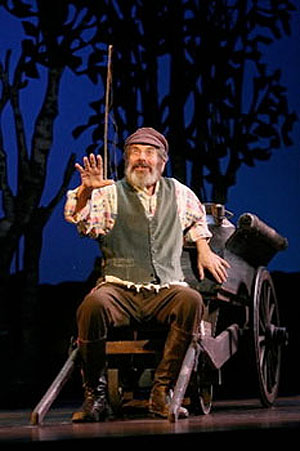Fiddler on the Roof at The Pantages Theatre
July 27, 2009 Leave a comment
 2,500 performances strong and Topol does not look like he’ll be slowing down in the role of Tevye in Tony Award-winning musical Fiddler on the Roof, which is now touring the U.S. in what is being called the actor’s farewell tour. It’s been a role identified with the actor since he appeared in the 1973 film version that earned him a Golden Globe award and an Academy Award nomination.
2,500 performances strong and Topol does not look like he’ll be slowing down in the role of Tevye in Tony Award-winning musical Fiddler on the Roof, which is now touring the U.S. in what is being called the actor’s farewell tour. It’s been a role identified with the actor since he appeared in the 1973 film version that earned him a Golden Globe award and an Academy Award nomination.
The touching story of Jewish life in turn of the century Russia deals with old world traditions on the eve of revolution. Tevye and his wife, Golde (Susan Cella) holds fast to the dying traditions that keep life in balance in the small town of Anatevka. He compares this precarious balance of traditions to a fiddler on the roof. But even before the changing world comes to his village, life is slowly unraveling for him when his eldest daughter, Tzeitel (Rena Strober) and Motel the Tailor (Erik Liberman) become engaged, going against the Matchmaker’s (Mary Stout) match to have her marry Lazar Wolf, the butcher (David Brummel), much to Tevye’s dismay. Perchi (Colby Foytik), a revolutionary student staying with Tevye’s family, upsets the traditions during Tzeitel and Motel’s wedding when he asks Hodel (Jamie Davis) to dance.
Later Perchi and Hodel reveal their union even as Perchi is arrested and shipped off to Siberia. Hodel goes to join him and his cause. So, his daughters pair off with men that they have fallen in love with, an idea that is foreign to the older folks in town and in this way, the younger generation forges their own traditions even as the world finally comes knocking at their door forcing them out and into an uncertain future.
Directed by Sammy Dallas Bayes, reproducing Jerome Robbins original choreography, the show never seems a nostalgic romp into Broadway canon. One thing that is very clear is the precision of the show, from staging to choreography to the nuances of the actors on stage.
But this production is, of course, all about Topol. In the role that made him a star, he never disappoints at over seventy years old. Every movement on stage is clearly coming from decades of portraying this father having to deal with his forward-thinking daughters. His voice, deep and precise, gives the character of Tevye a level of depth that is required for the role-especially when he has to hold firmly to his belief when he disowns his daughter Chava (Deborah Grausman) for marrying outside the faith.
But to say that it is only about Topol would be a mistake. Like a professional actor, he takes from what the newer actors give, thus giving it a fresh approach to the role. Cella as his wife of 25 years, matches Topol in scope as does the rest of the fine cast that makes up this touring production. This is almost necessary for a musical that’s been around for some time now. It not only entertains with memorable songs (music by Jerry Bock and lyrics by Sheldon Harnick) such as “Tradition,” “Matchmaker, Matchmaker,” and “If I Were a Rich Man;” but Joseph Stein’s book also digs deep into our own lives, whether we are Jewish or not, for the musical delves into the commonalities of all human beings: acceptance, change, family traditions, and sacrifice.



 Bitter Lemons
Bitter Lemons Picktainment
Picktainment EdgeLosAngeles
EdgeLosAngeles LA Stage Alliance
LA Stage Alliance Askew Theatre Company
Askew Theatre Company Hollywood Fringe Festival
Hollywood Fringe Festival LA Radar Festival
LA Radar Festival Goldstar
Goldstar Plays 411
Plays 411